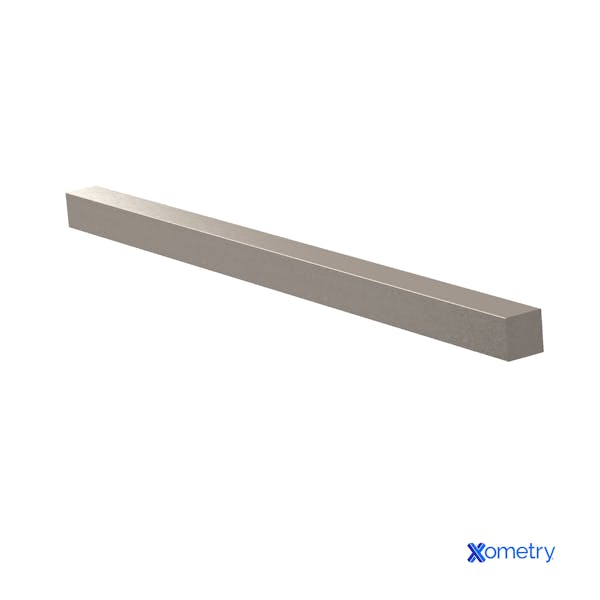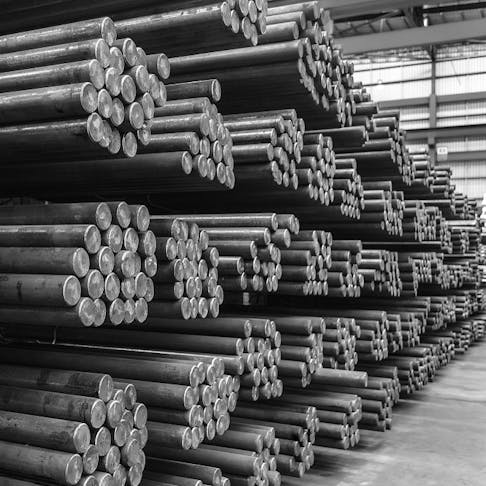4140 is a low-alloy steel used in many different industries and a popular material Xometry offers, thanks to its versatility. In order to give it special properties, this type of steel is alloyed with chromium and molybdenum. Because of these special properties, 4140 alloy steel is impressively tough and has quite a high torsional and fatigue strength. That’s why many industries like to use it for rotating components that undergo a significant amount of stress, like axles and shafts. 4140 steel comes in various forms, but mainly in bars.
Let’s learn more about this useful alloy steel.
What is 4140 Alloy Steel and How is it Used?
4140 alloy steel is mainly made from iron, but this isn’t surprising as this applies to all types of steel. It’s classed as a “chromoly” steel because it’s alloyed with carbon, chromium, molybdenum, and some other smaller components which makes it strong and wear- and corrosion-resistant.
Its superior strength makes 4140 alloy steel a popular go-to in the manufacturing world and a common choice among Xometry customers, especially those in the automotive industry. It’s ideal for products that need to be able to withstand a lot of stress and strain. These are oftentimes rotating components like drive shafts, axles, spindles, gears, and crankshafts, but the material can also be used for load-bearing stationary components, like bolts and chains.
Need Custom 4140 Steel Parts?
How 4140 Alloy Steel is Made
To make 4140 alloy steel, the components need to first be melted together in an electric or basic oxygen furnace at temperatures above 1500°C. Once they are melted and mixed, the molten steel result is poured out of the furnace to cool down. Next, the steel is annealed (reheated then cooled in a controlled way) to soften it and make it easier to work with.
It’s then dipped in hydrofluoric acid to get rid of rust and impurities that could have developed on the surface when heated. Casting is next; after the steel has been cleaned, it’s melted once again and poured into molds to make basic shapes called billets or slabs. The last step in the process is shaping. The billets/slabs made in the casting step are either hot- or cold-worked through rollers until they’re in the desired shapes and sizes.
Properties of 4140 Alloy Steel
Here are some typical properties of 4140 alloy steel:
| Property | Value |
|---|---|
Property Density [g/cm3] | Value 7.85 |
Property Yield Strength [MPa] | Value 415 |
Property Hardness (Brinell) | Value 197 |
Property Magnetism | Value Magnetic |
| Element | Composition [%] |
|---|---|
Element Carbon (C) | Composition [%] 0.38 - 0.43 |
Element Chromium (Cr) | Composition [%] 0.80 - 1.10 |
Element Molybdenum (Mo) | Composition [%] 0.15 - 0.25 |
Element Manganese (Mn) | Composition [%] 0.75 - 1.00 |
Element Silicon (Si) | Composition [%] 0.15 - 0.30 |
Element Sulfur (S) | Composition [%] 0.04 |
Element Phosphorus (P) | Composition [%] 0.035 |
Element Iron (Fe) | Composition [%] Balance |
Other Properties of 4140 Alloy Steel
As noted in the above table, 4140 alloy steel has a carbon content of between 0.38% and 0.43% making it a medium-carbon steel. For comparison, low-carbon steel usually has less than 0.3% carbon content. The materials’ machinability rating is around 65% when it’s in its annealed condition. If you were to add lead to the alloy (41L40), it would become more machinable, but lead tends to also make steel harder to weld and less pliable at higher temperatures.
In relation to its thermal properties, this type of alloy steel has a conductivity of 42.6 W/m•K. This places 4140 alloy steel in the average range as far as steels go but is still considered relatively low when compared to most metals which can be way more conductive. Another thermal property of 4140 alloy steel that places it in the average range is its thermal coefficient of expansion, which is rated at 12.2 µm/m•°C.
Common Forms of 4140 Alloy Steel
4140 alloy steel comes in various different forms, and we list the most common ones below.
- Sheets. 4140 alloy steel is often available in sheet form, usually between 1 and 10 mm thick. We will typically use this type of stock when customers require flat sheet cut parts made from 4140.
- Bars. Another common form you can find 4140 alloy steel available in, would be bars with cross sections that can either be flat, square, or round. Square and round bars are more popular and are thus available in dimensions from 6 mm up to 120 mm. We often use this type of stock for CNC machined parts.
- Plates. It’s also relatively common to come across 4140 alloy steel in the form of plates around 20–120 mm thick (but it’s not uncommon to find thicker ones of up to 300mm). These plates can be annealed, polished, and coated.
- Hot Rolled. 4140 alloy steel commonly comes in hot-rolled bars. That’s because round, flat, hex, and square bars go through this treatment. It’s worth noting, though, that hot-rolled bars have a different surface finish and won’t generally be as strong as cold-rolled types of 4140 alloy steel.
- Annealed. This is probably the most common form to find 4140 alloy steel in. That’s because, generally speaking, the steel has been annealed to allow it to be cold-formed into bars or plates. Annealing is great because it improves the flexibility of the steel in preparation for cold forming.
- Cold Drawn. You can also find 4140 alloy steel in cold-drawn bars which are round, flat, or square. Before the steel is cold drawn, it’s usually treated in order to form the softer pearlite microstructure, and this, in turn, makes it much more ductile.

4140 alloy steel bar
4140 Alloy Steel Equivalents
The composition of 4140 alloy steel goes by different names in certain parts of the world, depending on local standards. In the USA, we know it as 4140, and the standard is USA ASTM A29. Below you’ll find some of the global national standards and their equivalent 4140 grades.
| Country Standard | Equivalent Grade |
|---|---|
Country Standard China
GB/T 3077 | Equivalent Grade 42CrMo |
Country Standard Germany
DIN 17200 | Equivalent Grade 1.7225/
42crmo4 |
Country Standard Great Britain
BS 970 | Equivalent Grade 42CrMo4 |
Country Standard Japan
JIS G4105 | Equivalent Grade SCM440 |
Country Standard USA
ASTM A29 | Equivalent Grade 4140 |
Alloy Steel—Advantages and Disadvantages
4140 alloy steel has its pros and cons, and we list the most important ones below.
Advantages
This alloy type has high fatigue, tensile, and torsional strengths. It’s wear- and corrosion-resistant (thanks to its chromium and molybdenum), and can be easily hardened via heat treatment.
Disadvantages
The clearest disadvantage of 4140 alloy steel is that it is difficult to weld. Its weldability depends on its thermal treatment, with welding only recommended on annealed material. The metal must be preheated before welding. Afterward, it usually needs to be slow-cooled and heat-treated again.
Summary
This article presented and explained 4140 alloy steel, and discussed its various applications and its composition. You can find 4140 as a standard offering at Xometry. If you need custom parts made from this material, you can get an instant quote by uploading your CAD files to the Xometry Instant Quoting Engine® today!
Disclaimer
The content appearing on this webpage is for informational purposes only. Xometry makes no representation or warranty of any kind, be it expressed or implied, as to the accuracy, completeness, or validity of the information. Any performance parameters, geometric tolerances, specific design features, quality and types of materials, or processes should not be inferred to represent what will be delivered by third-party suppliers or manufacturers through Xometry’s network. Buyers seeking quotes for parts are responsible for defining the specific requirements for those parts. Please refer to our terms and conditions for more information.


